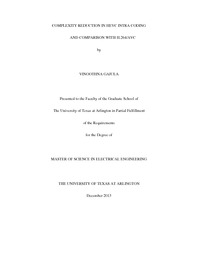
ATTENTION: The works hosted here are being migrated to a new repository that will consolidate resources, improve discoverability, and better show UTA's research impact on the global community. We will update authors as the migration progresses. Please see MavMatrix for more information.
Show simple item record
| dc.contributor.author | Gajula, Vinoothna | en_US |
| dc.date.accessioned | 2014-03-12T23:49:18Z | |
| dc.date.available | 2014-03-12T23:49:18Z | |
| dc.date.issued | 2014-03-12 | |
| dc.date.submitted | January 2013 | en_US |
| dc.identifier.other | DISS-12456 | en_US |
| dc.identifier.uri | http://hdl.handle.net/10106/24085 | |
| dc.description.abstract | ITU-T (VCEG) and ISO/IEC (MPEG) collaborated and formed the joint collaborative team on video coding (JCT-VC) in April 2010 to develop the next-generation video coding (NGVC) standard.. HEVC standard doubles the coding efficiency and the approximately 50% less bit rate with respect to H.264/AVC, at nearly the same video quality at expense of increased complexity. In this thesis, a technique is proposed to reduce the complexity of HEVC intra coding to get better encoding time, involving two steps - first by optimizing the PU (prediction unit) size decision process using texture complexity analysis by intensity gradients and second to obtain the reduced prediction modes by applying a combination of rough mode decision (RMD) and most probable modes (MPM) thereby reducing the number of modes based on rate distortion optimization (RDO) followed by residual quad-tree (RQT) which is used to simplify the entire processThe technique developed in this thesis achieved an average gain of 47.25% encoder time when implemented for several test sequences at very less loss in performance with high complexity reduction. | en_US |
| dc.description.sponsorship | Rao, Kamisetty R. | en_US |
| dc.language.iso | en | en_US |
| dc.publisher | Electrical Engineering | en_US |
| dc.title | Complexity Reduction In HEVC Intra Coding And Comparison With H.264/AVC | en_US |
| dc.type | M.Engr. | en_US |
| dc.contributor.committeeChair | Rao, Kamisetty R. | en_US |
| dc.degree.department | Electrical Engineering | en_US |
| dc.degree.discipline | Electrical Engineering | en_US |
| dc.degree.grantor | University of Texas at Arlington | en_US |
| dc.degree.level | masters | en_US |
| dc.degree.name | M.Engr. | en_US |
Files in this item
- Name:
- Gajula_uta_2502M_12456.pdf
- Size:
- 2.058Mb
- Format:
- PDF
This item appears in the following Collection(s)
Show simple item record


